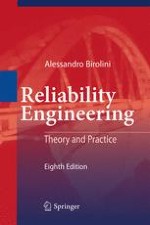2017 | OriginalPaper | Buchkapitel
Reliability & Availability of Repairable Systems
verfasst von : Prof. Dr. Alessandro Birolini
Erschienen in: Reliability Engineering
Verlag: Springer Berlin Heidelberg
Aktivieren Sie unsere intelligente Suche, um passende Fachinhalte oder Patente zu finden.
Wählen Sie Textabschnitte aus um mit Künstlicher Intelligenz passenden Patente zu finden. powered by
Markieren Sie Textabschnitte, um KI-gestützt weitere passende Inhalte zu finden. powered by
Reliability and availability analysis of repairable systems is generally performed using stochastic processes, including Markov, semi-Markov and semi-regenerative processes (Table 6.1). A careful introduction to these processes is in Appendix A7 with reliability applications in mind. Equations for Markov and semi-Markov models are summarized in Table 6.2. This chapter investigates many of reliability models encountered in practical applications (some of which new in Sections 6.8 - 6.11), andreliability figures at system level will have indices S i. (e. g. MTTF Si ), where S stands for system and i for the state Z i entered at t = 0 (footnote on p. 512).After a discussion on assumptions and conclusions, Section 6.2 investigates the one item structure under general conditions. Sections 6.3 - 6.6 deal with series, parallel and series - parallel structures. To unify models and simplify calculations, it is assumed that systems have only one repair crew and no further failures occur at system down. Starting from constant failure and repair rates (Markov models) generalization is performed beginning with repair rates, up to the case in which the process involved is regenerative with a minimum number of regeneration states. Approximate expressions for large series - parallel structures are given in Section 6.7. Section 6.8 considers systems with complex structure for which a reliability block diagram often does not exist. On the basis of practical examples, preventive maintenance, imperfect switching, incomplete coverage, elements with > 2 states, phased-mission systems, common cause failures, and general reconfigurable fault tolerant systems with reward and frequency / duration aspects are investigated. Network reliability is introduced in Section 6.8.8 and a general procedure for complex structures is in Section 6.8.9. Section 6.9 considers alternative methods (dynamic FTA, BDD, event trees, Petri nets, computer-analysis), and gives a Monte Carlo approach useful for rare events. Sections 6.10 and 6.11 deal with human reliability and risk management. Results are summarized in tables. Asymptotic and steady-state is used for stationary, mean for expected value. Selected examples illustrate the practical aspects.
